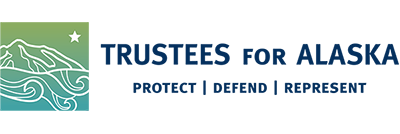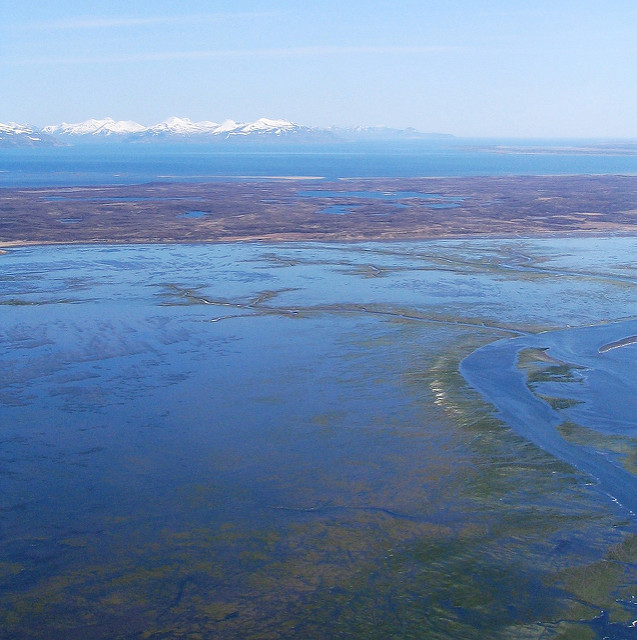
What does the law do? ANILCA and public lands in Alaska
Welcome to our first piece in a series of articles about what the laws we use do and how they protect the lands, waters and animals important to people and our climate future.
By Madison Grosvenor
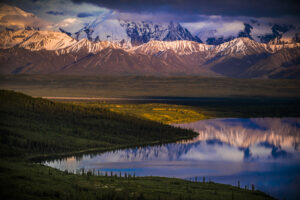
Midnight sun on Wonder Lake and the Alaska Range. Photo by Kent Miller, NPS
Alaska’s wild places are made up of towering peaks that meet the sea, sprawling tundra, ancient forests, and waterways teeming with life. It’s home to iconic wildlife like grizzly bears, caribou, and salmon, who thrive in these vast natural landscapes.
From Denali’s glaciers to the Yukon Delta’s wetlands, these lands not only play a central role in Alaska’s identity to its human inhabitants, but they also inspired Congress to pass a law designed to protect these places—the Alaska National Interest Lands Conservation Act or ANILCA.
Managing such a vast and varied area requires balancing the need for conservation with other human needs. Signed into law by President Jimmy Carter in 1980, ANILCA protected more than 104 million acres while ensuring local communities could continue to rely on these lands for subsistence and their livelihoods. More than just a policy, ANILCA created a framework for conserving Alaska’s wild places while honoring the deep cultural connection of Alaska Native people, who have stewarded these lands for generations.
“This law made a profound contribution to how we recognize and honor Alaska ways of life and landscapes,” said Vicki Clark, executive director with Trustees. “Anyone who steps into a national park, refuge or wilderness area in Alaska, whatever their draw to the land, experiences these places in a more essential way because ANILCA preserved the relationships between natural landscapes, animals, and people.”
Teeing up ANILCA
The push to protect areas in Alaska for national interest began before statehood, driven by the recognition that commercial interests in extracting oil, timber, fish, minerals and metals would have impacts on people and animals. Early conservation efforts, such as the establishment of the Tongass and Chugach national forests and national parks like Glacier Bay and Denali, gained bipartisan support.

President Jimmy Carter celebrates after signing the Alaska National Interest Conservation Act on December 2, 1980. Jimmy Carter Presidential Library photo.
Upon statehood in 1959, the state gained the right to select 105 million acres of federal land, which included areas like Prudhoe Bay. The discovery of oil in 1968 led to conflicts over land use, particularly with Alaska Native people, who asserted their land claims before a pipeline could be built.
In 1971, Congress passed the Alaska Native Claims Settlement Act or ANCSA, granting 44 million acres and nearly $1 billion to newly created Alaska Native corporations while extinguishing aboriginal land claims. However, ANCSA did not address Alaska Natives’ subsistence rights, leaving their future access to traditional resources uncertain. It also left federal land conservation unresolved, though it authorized the Interior Secretary to withdraw up to 80 million acres for potential protection as parks, refuges, national forests, wild and scenic rivers, or wilderness areas.
Those withdrawals were not permanent; they required subsequent action to ensure permanent protection. ANILCA was born out of this tension.
What does ANILCA do?
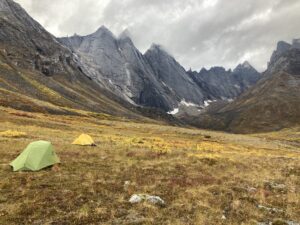
Tents in Arrigetch Valley in Gates of the Arctic National Park. Photo by Claire Dal Nogare, NPS
ANILCA set aside over 104 million acres of land for national parks, wildlife refuges, and wilderness areas—more than doubling the size of existing protected areas like Denali and Katmai national parks and the Arctic National Wildlife Refuge, while also creating entire new national parks, like Gates of the Arctic and Lake Clark.
Beyond establishing new parks and wilderness areas, ANILCA put strong safeguards in place to prevent land and large-scale industrialization, requiring congressional approval for any major changes. It set a new standard for conservation by recognizing the importance of protecting vast, interconnected ecosystems for people and animals.
With ANILCA, Alaska’s national parks and refuges were guaranteed to be managed with conservation as the priority.
As stated by Congress, “…it is the intent of Congress in this Act to preserve unrivaled scenic and geological values associated with natural landscapes; provide for the maintenance of sound populations of, and habitat for, wildlife species of inestimable value to the citizens of Alaska and the Nation; preserve in their natural state extensive unaltered tundra, boreal forest, and coastal rainforest ecosystems; protect the resources related to subsistence needs; protect and preserve historic and ecological sites, rivers, and lands; and preserve wilderness resource values and related recreational opportunities.”
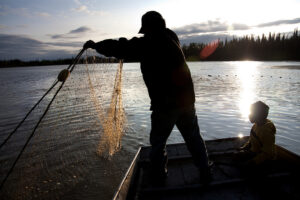
ANILCA provides access for traditional subsistence practices for Alaska Native people. NPS photo.
What sets ANILCA apart from many conservation laws is its recognition of Indigenous peoples’ long stewardship of these lands. It gives rural residents, especially Alaska Natives, priority for subsistence hunting and fishing. This federal law defines subsistence uses as hunting, fishing, and gathering for food, clothing, shelter, fuel, transportation, and making handicrafts, for survival and cultural traditions. The word “subsistence” means putting food on the table and sustaining Alaska Native identities, cultures, customs, traditions, values and beliefs.
ANILCA’s recognition of Indigenous stewardship and its focus on subsistence rights underscores the law’s commitment to the needs of Alaska’s people and its wild places.
ANILCA’s role in our work
Since the passing of ANILCA, it has become one of our greatest legal tools for defending Alaska’s public lands from massive industrial infrastructure, pollution, and land destruction, including roads, pipelines, oil platforms, toxic waste areas, and much more. The act is at the forefront of a lot of our work, both past and present.
ANILCA looms large in our litigation to protect the Izembek National Wildlife Refuge.
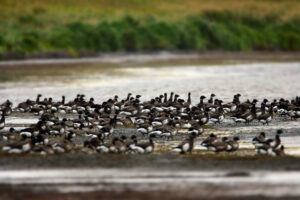
Black Brant gathering at water hole in Izembek National Wildlife Refuge. Photo by Ryan Hagerty, USFWS.
Since the 1980s, commercial interests have advocated for a road on the Izembek Isthmus for commercial interests and allied businesses that process and transport fish, among other potential activities. The road would threaten the health of a narrow isthmus and wetland region that supports an array of birds, fish, and animals important to the refuge and nearby communities.
We’ve won in court before on Izembek, but here we are yet again, with yet another land swap proposed. In late 2024, the Biden administration put out a draft analysis and identified a land swap and road as its preferred alternative.
ANILCA explicitly protects Izembek. While it allows land exchanges to further its conservation goals, it does not permit trading lands solely for private economic purposes. These land swap attempts have repeatedly ignored and undermined the purposes outlined within ANILCA and the particular refuge statute itself. ANILCA’s intent is clear: to preserve Alaska’s wildlife, habitat, and subsistence resources—all of which a road through Izembek would certainly endanger.
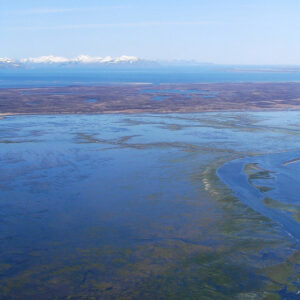
The Izembek isthmus makes up the heart of the refuge. Photo by Kristine Sowl, USFWS.
And a land exchange also tries to go around a key part of ANILCA: Title XI. Title XI of ANILCA provides a process for approving transportation and other infrastructure projects on protected lands, requiring agencies to prove that no feasible alternative exists, and in the case of Wilderness like in Izembek, to go through Congress.
“If a current land swap to make way for this road goes through, it would set the dangerous precedent of an Interior Secretary giving public lands to private interests without congressional oversight,” said Siobhan McIntyre, staff attorney. “The impact would be enormous and devastating, potentially opening the door to similar land exchanges in any national park, refuge or wilderness area in Alaska. Roads, pipelines, and webs of industrial infrastructure could cross through the very national park lands that Alaskans cherish and visitors from throughout the country and world come to Alaska to see.”
ANILCA is also central to our work to stop the Ambler road proposal. The 211-mile industrial road plan would cut through Gates of the Arctic National Preserve, once again triggering Title XI’s strict review process for transportation projects in conservation lands.
The law also plays a part in our Arctic National Wildlife Refuge work, as it affirms the refuge’s conservation priorities and mandates the protection of its wildlife habitat and subsistence resources. Upholding ANILCA in the refuge is crucial to protecting the Porcupine caribou herd and the Gwich’in way of life.
A law under fire
The immeasurable power of ANILCA to protect public lands in Alaska plays a big part in our work on behalf of people today and for generations to come.
The Trump administration clearly seeks the industrialization of Alaska across the board, as executive orders direct the heads of agencies to reverse or rescind protective actions while pushing industrial interests across the state. Direct affronts to ANILCA are expected to come consistently over the next four years.
As industry and political interests continue to test the limits of laws like ANILCA, we continue defending them. One reason advocates of ANILCA saw the need for the law in the first place was to prevent the loss of lands to industrialization and destruction that so many other states had endured.
ANILCA remains one of our most powerful tools in ensuring that future generations can experience, live within, and be nourished by these landscapes for years to come.
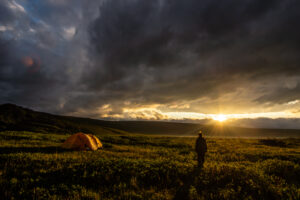
Camping under the midnight sun in the Arctic National Wildlife Refuge. Photo by Alexis Bonogofsky for USFWS.


